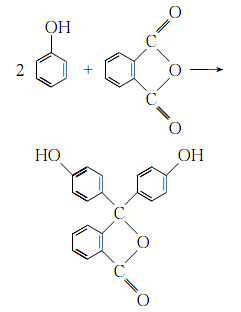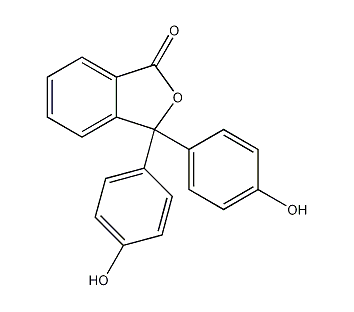Phenolphthalein Phenolphthalein


Structural formula
| Business number | 01LN |
|---|---|
| Molecular formula | C20H14O4 |
| Molecular weight | 318.32 |
| label |
3,3-bis(4-hydroxyphenyl)-1(3H)-isobenzofuranone, 3,3-bis(4-hydroxyphenyl)-3H-isobenzofuranone, 3,3-bis(p-hydroxyphenyl)phthalide, 3,3-Bis(4-hydroxyphenyl)-1(3H)-isobenzofuranone, Acid-base indicator |
Numbering system
CAS number:77-09-8
MDL number:MFCD00005913
EINECS number:201-004-7
RTECS number:SM8380000
BRN number:284423
PubChem number:24899058
Physical property data
1. Character: colorless or slightly yellow crystal
2. Density (g/mL, 25/4℃): 1.277g/ml
3. Relative vapor density (g/mL, air=1): 1.299
4. Melting point (ºC): 257~259℃
5. Boiling point (ºC, normal pressure): Uncertain
p>
6. Boiling point (ºC, 5.2kPa): Uncertain
7. Refractive index: Uncertain
8. Flash point (ºC): Uncertain
p>
9. Specific rotation (º): Uncertain
10. Autoignition point or ignition temperature (ºC): Uncertain
11. Vapor pressure (kPa , 25ºC): Uncertain
12. Saturated vapor pressure (kPa, 60ºC): Uncertain
13. Heat of combustion (KJ/mol): Uncertain
14. Critical temperature (ºC): Uncertain
15. Critical pressure (KPa): Uncertain
16. Log value of oil-water (octanol/water) partition coefficient : Uncertain
17. Explosion upper limit (%, V/V): Uncertain
18. Explosion lower limit (%, V/V): Uncertain
19. Solubility: Soluble in ethanol and alkali solution, slightly soluble in ether, 1g soluble in 12ml ethanol, about 100ml ether, very slightly soluble in chloroform, insoluble in water
Toxicological data
1. Acute toxicity
Human oral TDLO: 29 mg/kg
Rat oral LD50:>1 mg/kg
Rat abdominal LD50: 500mg/kg
2. Other multiple dose toxicity data
Rat caliber TDLO: 324 gm/kg/13W-C
Mouse caliber TDLO: 106 gm/kg/13W-C
3. Chronic toxicity/carcinogenicity:
Rat caliber TDLO: 364mg/kg/2Y-C
Mouse Caliber TDLO: 281mg/kg/2Y-C
4. Teratogenicity
Mouse: 1680 mg/kg/14D
Ecological data
None yet
Molecular structure data
1. Molar refractive index: 88.10
2. Molar volume (cm3/mol): 229.7
3. Isotonic specific volume (90.2K): 652.3
4. Surface tension (dyne/cm): 65.0
5. Polarizability (10-24cm3): 34.92
Compute chemical data
1. Hydrophobic parameter calculation reference value (XlogP): 3.6
2. Number of hydrogen bond donors: 2
3. Number of hydrogen bond acceptors: 4
4. Number of rotatable chemical bonds: 2
5. Number of tautomers: 3
6. Topological molecular polar surface area (TPSA): 66.8
p>
7. Number of heavy atoms: 24
8. Surface charge: 0
9. Complexity: 438
10. Number of isotope atoms : 0
11. Determine the number of atomic stereocenters: 0
12. Uncertain number of atomic stereocenters: 0
13. Determine the chemical bond configuration Number of centers: 0
14, Number of uncertain chemical bond stereocenters: 0
15, Number of covalent bond units: 1
Properties and stability
1. It turns red when dissolved in dilute alkali solution.
Storage method
Store sealed at room temperature.
Synthesis method
1. It is prepared by mixing phthalic anhydride and phenol and then co-heating with sulfuric acid.
2.Melt 160kg of phenol, maintain the temperature at 80~90℃, and add 120kg of phthalic anhydride and 40kg of phthalic anhydride while stirring. Zinc chloride, 5.5kgsulfuric acid, react for 5 hours, then heat up to 180°C, react for 40 hours:

Reaction ends Then add water, stir continuously, boil with steam, then stop heating, let it stand, suck out the upper waste acid liquid, wash the precipitate with water until ph>5, centrifuge and spin dry, then wash with water until colorless, and dry below 80°C. Add 4 times of industrial ethanol (>95%) to the dry crude phenolphthalein, and add activated carbon (6kg of activated carbon for every 110kg of crude product), and heat and reflux with steam for 5 minutes while stirring. Stop heating and filter. The filtrate is evaporated and concentrated, and ethanol is recovered. When concentrated to an appropriate level, quickly centrifuge and spin dry, wash with ethanol 1 to 2 times, dry, and sieve through a 40-mesh sieve.
Purpose
1. Used as an indicator in acid-base titration in the laboratory, the color change range is pH8.2~10.0, from colorless to red.
2. Used medicinally as a laxative, it can stimulate the intestinal wall, cause intestinal peristalsis and promote defecation.
